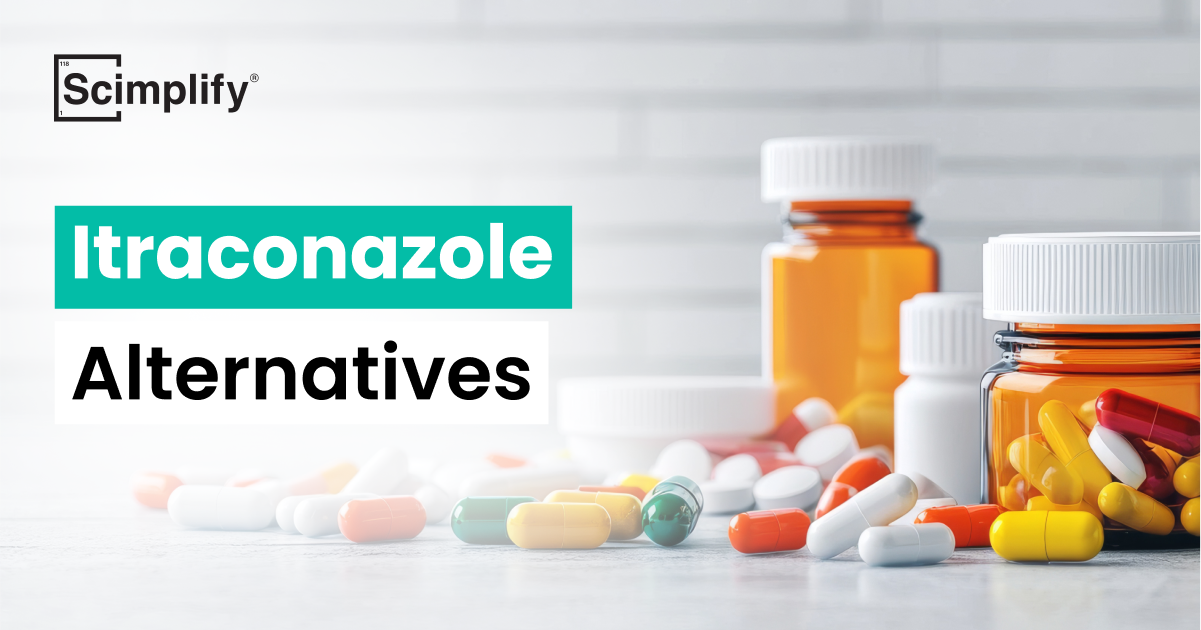Itraconazole is a synthetic triazole antifungal agent first used in the 1980s. Its broad-spectrum activity makes it viable to be used to prevent and treat fungal infections. The drug also serves a wide range of use cases, from treating superficial skin conditions to life-threatening systemic mycoses.
Itraconazole’s oral and intravenous bioavailability makes long-term therapy feasible for chronic fungal diseases. However, it has pharmacokinetic variability and significant drug interactions, requiring therapeutic drug monitoring to ensure effective and safe dosing.
In this blog, we will look at the top alternatives to Itraconazole with their pros and side effects.
Alternative products for Itraconazole
1. Fluconazole
Fluconazole is a triazole antifungal with potent activity against yeast infections. However, it has limited action against molds and lacks coverage for Aspergillus and dimorphic fungi. So, it acts as an alternative for superficial and systemic fungal infection treatment.
Pros
- Excellent oral bioavailability, even without food.
- Good CNS penetration, making it practical for fungal meningitis.
Side effects
- No mold activity, ineffective against Aspergillus.
- Higher resistance rates, especially in C. glabrata and C. krusei.
- Minimal tissue penetration, limiting its use for deep-seated infections.
Explore buying and manufacturing options for Fluconazole
2. Voriconazole
Voriconazole is a broad-spectrum triazole antifungal used to treat invasive aspergillosis. It also has enhanced activity against fluconazole-resistant Candida species. This makes it an alternative to Itraconazole for mold infections.
Pros
- Highly effective against Aspergillus, replacing amphotericin B in severe cases.
- Broad spectrum, covering Candida, Fusarium, and Scedosporium.
- Suitable oral and IV formulations, enabling flexible dosing.
Side effects
- Visual disturbances (photopsia, light sensitivity) in ~30% of patients.
- Complex metabolism requires therapeutic drug monitoring.
- It is high-cost, making it less accessible than older antifungals.
Explore buying and manufacturing options for Voriconazole
3. Posaconazole
Posaconazole is used for the treatment of Mucormycosis, Candida, and Aspergillus. Thus, it is a strong alternative for itraconazole-resistant or refractory infections.
Pros
- Covers Mucorales fungi, unlike fluconazole or voriconazole.
- Long half-life, allowing once-daily dosing.
- Effective for prophylaxis in immunocompromised patients.
Side effects
- Expensive, limiting widespread use.
- Absorption issues, requiring high-fat meals for bioavailability.
- Drug interactions, as it inhibits CYP3A4.
4. Amphotericin B (Liposomal Formulations)
Amphotericin B is a polyene antifungal that directly disrupts fungal membranes. This makes it the gold standard for life-threatening fungal infections resistant to azoles.
Pros
- Broadest spectrum, covering almost all pathogenic fungi.
- Fungicidal action leads to rapid clearance of infections.
- No azole resistance issues, as it has a different mechanism.
Side effects
- Nephrotoxicity, though liposomal forms, reduces this risk.
- Infusion-related side effects requiring premedication.
- IV-only formulation, making outpatient use difficult.
5. Propiconazole (Triazole Fungicide)
Propiconazole is a systemic demethylation inhibitor fungicide that prevents fungal diseases in crops like wheat, corn, and turf. This makes it an agricultural alternative to Itraconazole’s antifungal properties.
Pros
- Systemic action, protecting new plant growth.
- The long residual effect reduces spray frequency.
- Broad disease control is effective against rust, mildew, and leaf spots.
Side effects
- Resistance concerns, as DMI fungicides face declining efficacy.
- Environmental toxicity affecting aquatic ecosystems.
- Limited oomycete control is ineffective for late blight or downy mildew.
Explore buying and manufacturing options for Propiconazole
6. Copper-Based Fungicides (Bordeaux Mixture, Copper Hydroxide)
Copper fungicides are multi-site protectant fungicides widely used in organic farming to control plant fungal diseases, serving as a sustainable alternative to azoles like itraconazole.
Pros
- Low resistance risk, as it acts on multiple fungal pathways.
- Effective against bacterial diseases, unlike triazoles.
- Approved for organic farming, making it widely accepted.
Side effects
- Phytotoxicity, potentially damaging crops at high doses.
- Environmental accumulation leads to soil and water contamination.
- Non-systemic, requiring repeated applications for sustained protection.
7. Biological Fungicides (Trichoderma, Bacillus subtilis)
Beneficial microbes like Trichoderma and Bacillus subtilis act as natural antifungal agents in agriculture, offering a biological alternative to synthetic fungicides like itraconazole.
Pros
- Eco-friendly, with minimal environmental impact.
- No resistance issues due to multi-mode antagonistic effects.
- Soil health benefits, improving root growth and nutrient uptake.
Side effects
- Slower action, needing a preventive application.
- Variable efficacy, depending on environmental conditions.
- Limited spectrum, requiring combination with chemical fungicides.
8. Tebuconazole (Wood Preservative Fungicide)
Tebuconazole is a structural analog of itraconazole—used in wood treatments to prevent fungal decay in lumber, making it a direct industrial alternative.
Pros
- Long-lasting protection, persisting in wood for decades.
- UV and leach-resistant, improving wood durability.
- Effective at low doses, minimizing environmental impact.
Side effects
- Aquatic toxicity, raising environmental concerns.
- Limited to structural fungi, requiring insecticide pairing for termites.
- Regulatory scrutiny, with bans in some countries.
Explore buying and manufacturing options for Tebuconazole
9. Iodopropynyl Butylcarbamate (IPBC) (Antifungal Paint Additive)
Iodopropynyl Butylcarbamate is a broad-spectrum fungicide used in paints, adhesives, and coatings. It prevents mold and mildew growth, serving as an industrial alternative to itraconazole.
Pros
- Highly potent and effective at low concentrations.
- Long-lasting—ensuring mildew resistance in paints and coatings.
- Non-volatile, providing stable in-product protection.
Side effects
- Allergenic potential causing skin irritation in some individuals.
- UV degradation requires a combination with other stabilizers.
- It is not systemic, so it only prevents surface mold, not deep penetration.
10. Borate Compounds (Borax, Boric Acid – Wood & Textile Preservative)
Borate-based antifungals prevent wood decay and textile mildew, offering a natural alternative to synthetic antifungal agents like itraconazole in industrial applications.
Pros
- Dual antifungal & insecticidal action, protecting against rot and termites.
- Non-toxic to humans, making it safer for household use.
- No resistance issues, with stable long-term efficacy.
Side effects
- Water-soluble, leading to leaching in wet conditions.
- Surface-only protection requires deep penetration for full efficacy.
- Limited outdoor durability unless combined with water-resistant coatings.


